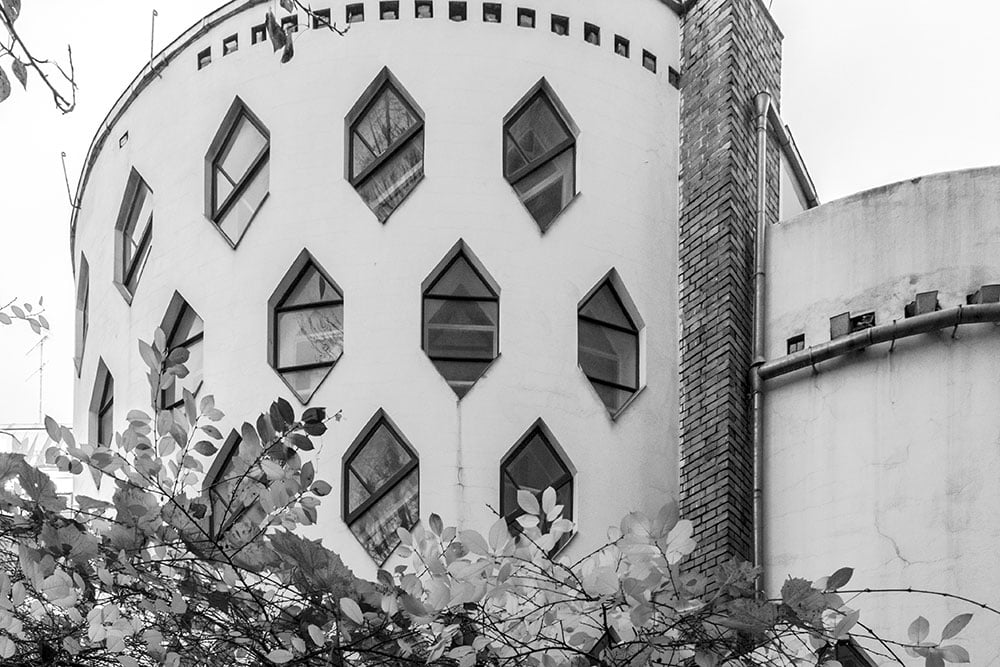4 New East jogging routes for architecture fanatics
The New East’s cities are packed with so many modern architectural highlights, it can be hard to know how to fit them in. Luckily, the health-conscious Brutalism enthusiast can kill two birds with one stone by grabbing their trainers and hitting the concrete. We’ve curated four runs of 5-8km that showcase some of the best post-war buildings in Moscow, Belgrade, Kiev, and St Petersburg. Time to get fit and increase your Instagram followers in the same afternoon.
Moscow — Ostankino and VDNKh
Start: Ostankino TV Tower
Finish: Worker and Kolkhoz Woman statue
Length: approx. 5km
Moscow is a city where you can catch any number of architectural styles on the go, with Brutalist concrete gems lost amid pompous Stalinist towers and swish post-Soviet skyscrapers.
The VDNKh exhibition centre is a case in point —while many of its pavilions were built in the grand, post-war Stalinist style, the park and surrounding area is home to a large concentration of Modernist buildings.
Start at the Ostankino Television Tower, which overlooks a lake and park, as well as the exhibition centre. Built in 1967, it briefly held the record for the world’s highest building. The 540-metre structure was allegedly envisioned as an upside-down flower, and its concrete base really does recall a lily. You’ll need a ticket to access, so it may be better to observe from the outside.
Keep going down the wide, tree-lined Akademika Koroleva Street towards the VDNKh metro station, past Soviet residential estates and tower blocks. The street is named after the famous Soviet rocket engineer and chief of the Soviet space programme, but only adopted his surname after Korolev’s death in 1966: in life, his identity was a secret, with the authorities fearing that he risked assassination were it to come out.
Continuing the space theme, cross the road into the Cosmopark, where you can admire the parabolic Monument to the Conquerors of Space.
Use the underpass under Prospect Mira to reach the crescent-shaped Cosmos hotel, built to accommodate guests during the Moscow 1980 Olympics. Continue along Prospect Mira, or smaller side streets, until you reach Borisa Galushkina Street and the famous “house on stilts”.
This 25-floor residential block was built in 1968. There are several theories as to why its architects decided to put it on stilts: some say they took their inspiration from South East Asian architecture; other that the decision was ecologically motivated, allowing car fumes from Prospect Mira to be ventilated. From here, continue to the nearby Zholtovsky House, a 1950s yellow building with glass lift shafts situated on the exterior.
The small grey building across the road is the Dormitory of Cotton Factory Workers, built by famous Soviet architect Moisei Ginzburg, also known for his Constructivist Narkomfin house. Your route finishes at the Worker and the Kolkhoz Woman statue by the entrance to VDNKh. For a longer run, head inside the park to take in all its pavilions.
Belgrade — New Belgrade and Park of Friendship
Start: Genex Tower
Finish: Museum of Contemporary Art
Length: approx. 8km
When you think of Belgrade Brutalism, the Genex Tower comes immediately to mind. Also known as the Western City Gate, it consists of two high rises connected by a bridge, and was completed in 1979. This is where your route begins, in block 33 of New Belgrade (Novi Beograd), the district originally intended as the epicentre of Tito’s Yugoslavia.
Head through the green pedestrian areas of Arsenija Čarnojevića Boulevard for one block, and then cross the road until you reach block 28. Here, standing alongside the main highway, is an exceptionally long building called the Televizorka, or the “TV screen”. The name comes from the small square windows that dot the facade, as disliked by residents as they are admired by fans of Brutalism. From here you can see the horseshoe-shaped estate known as Potkovica.
Following Španskih Boraca Street between blocks 29 and 25 will take you to Zorana Đinđića Boulevard. Here, turn left after block 21 to see the “Great Wall” — the longest residential building in Belgrade, snaking across the block for nearly a kilometre and housing 3,500 people (and featuring 62 entrances, 6,380 doors, and 5,152 windows). Next to Wall are six high rises nicknamed the “six corporals”.
Cross Mihajla Pupina Boulevard and head towards the big white building known as the Palace of Serbia, or SIV 1, which houses government offices. This was one of the first buildings to be constructed in New Belgrade, and remains one of the largest in terms of surface area.
From here, you can reach the embankment by crossing Nikola Tesla Street and passing the leafy Park of Friendship. Follow the river (for now it’s the Danube, but it meets the Sava at the edge of the park) until you see the alley that will take you to the Eternal Flame monument
You can then head onto the Alley of Peace, whose trees were planted by a diverse list of historical figures and celebrities, from Tito and Haile Selassie, to Richard Nixon, Kim Il Sung, and the Rolling Stones.
The final part of your run takes you through block 15, where you will pass Belgrade’s Museum of Contemporary Art and the surrounding sculpture park. Originally built in 1965, the Museum reopened in 2017 after a controversy-ridden 10-year “renovation”. You can stop to take in its permanent collection of Serbian art, or continue down the bank of the Sava for another two kilometres.
Kiev — cross-town Modernism
Start: Ukrainian House
Finish: Institute of Information
Length: approx. 8km
You route starts at the Ukrainian House, at the beginning of Khreschyatik Street. The House was originally intended as the Kiev branch of Moscow’s Lenin Museum, and since 1993 the building has been an international exhibition and congress centre.
From here, use the underpass to cross Volodymirski Descent, and continue towards the steps that will lead you into Khreschyatiy Park. There’s an uphill stretch until you reach the Friendship of Nations Arch, built in the early 1980s to commemorate the friendship between the Ukrainian and Russian peoples. Since the “decommunisation” law came into effect, there have been many discussions as to whether to preserve or raze the arch. Luckily, for now it still stands.
Check out the views of the river from the viewing platform and continue through the park along the path towards the Dynamo stadium. Circumvent the stadium to see the wooden Mushlya summer theatre in Mariyinskiy Park. Also known as the Rakushka (“Shell”) or “the small turtle” after its unusual shape, it was built by architect Yury Seregin in the early 1980s.
Then continue through Mariyinskiy Park to Arsenalna metro station, the deepest in the world. Leave the trek up and down the escalators for another time and take in the square, domed building from the outside, before continuing down Ivana Mazepy Street to the beehive-esque Salut hotel. Built in 1984, it was initially intended as a high-rise; funding for the project was slashed, however, after the architects refused to add a Party official to the list of the building’s authors, which ultimately meant the number of floors had to be reduced.
Salut’s architect, Avraam Miletsky, was also responsible for the construction of the neighbouring Palace of Children and Youth (known as the Palace of the Pioneers in the Soviet era), which housed extracurricular activities for kids. A modern business centre has been tacked onto the side, much to the chagrin of Miletsky’s surviving co-author Eduard Bilskiy.
Cross the road and continue down Mykhaila Omelianovycha Pavlenka Street as it merges with Moskovska Street. Once at Henerala Almazova Street, you will be able to make out the building of the CDAGO (Central State Archives of Public Organisations of Ukraine). Then turn onto Lesi Ukrainky Boulevard.
Continue down the boulevard past various apartment blocks until you reach Druzhbi Narodiv Boulevard, where you need to turn left; almost immediately you’ll come across the Modernist Furniture House, recognisable for its tent-like roof.
Continue down the same boulevard until you reach Lybidska metro station. You’ll need to use the underpass to access the main attraction here: the spacecraft-inspired Institute of Information, known among locals as “the saucer on Lybidska”. The round part of the building houses the Institute’s main assembly hall. Legend has it that the amount of land allocated for the project was insufficient to include a suitably grand lecture hall — hence the need to suspend the space over the street in the striking saucer structure. The building’s architect Florian Yuryev, however, had initially suggested a different use for the space. An artist and musician, he was fascinated by synesthesia, and proposed a theatre of light and sound be built instead.
St Petersburg — Primorskaya
Start: Primorskaya metro station
Finish: Sea terminal
Length: approx. 7km
Start at Primorskaya metro, then cross Nalichnaya Street and head along the Novosmolenskaya Embankment. Notice the buildings that you’re passing on your right, with blocks of differing heights interconnected with giant arches. The original design dictated that these buildings would increase in height the closer they were to the sea. While the project was never fully realised, they managed to construct the residential blocks on either side of the river before the Soviet Union collapsed.
At the end of the block, cross Korablestroiteley Bridge and continue on to the other side of the river, where you’ll notice the Modernist influences of Le Corbusier, Moisei Ginzburg, and Oscar Niemeyer manifested in the series of buildings on stilts — or “houses on chicken feet”, as they are known among locals.
When you reach Nalichnaya Street, cross it and note the white marble building with a tower, which houses the Arctic and Antarctic Research Institute. Continue down Nalichnaya until you reach Nakhimova Street, where you will need to turn right and continue until you reach the end of the street. Across the road is the Pribaltiyskaya hotel, built in 1978. The hotel’s name means “by the Baltic Sea”, despite the building still being some distance from the embankment; when it was built, this was still the waterfront, but the embankment has been expanded since.
Sticking to the right side of Nakhimova Street, continue for one block until Maliy Prospect, which will take you back to Nalichnaya. You will pass a series of panel houses until you reach the entrance to the LenExpo exhibition centre. Don’t miss pavilion number six, a striking, triangular building right on the water. Featuring a futuristic wavy roof, the building now houses the Chinese pavilion.
Make sure there isn’t an event on in the exhibition centre, as otherwise you might not be able to get in without a ticket. Continue down along the water until you exit LenExpo and end up at the cruiseship-like building of the St Petersburg Sea Terminal, by Constructivist architect Noi Trotsky. The facade is decorated with white panels that are meant to resemble boat sails. Look close enough and you’ll see that the building’s 80-metre spire is also topped with a tiny metal boat.


